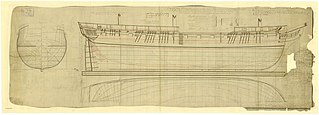Related Research Articles
Several ships have borne the name Black Joke, after an English song of the same name.

Armide was a 40-gun frigate of the French Navy, lead ship of her class, and launched in 1804 at Rochefort. She served briefly in the French Navy before the Royal Navy captured her in 1806. She went on to serve in the Royal Navy until 1815 when she was broken up.
During the French Revolutionary and Napoleonic Wars the British Royal Navy made use of hired armed vessels, one of which was His Majesty's hired armed cutter Nimrod. Three such vessels are recorded, but the descriptions of these vessels and the dates of their service are such that they may well represent one vessel under successive contracts. The vessel or vessels cruised, blockaded, carried despatches, and performed reconnaissance.
During the French Revolutionary and Napoleonic Wars the Admiralty also made use of hired armed vessels, one of which was His Majesty's Hired armed cutter Swan. Actually there were two such cutters, but the descriptions of these vessels and the dates of their service are such that they may well represent one vessel under successive contracts. The vessel or vessels cruised, blockaded, carried despatches and performed reconnaissance.
During the period of the Napoleonic Wars, two vessels have served the British Royal Navy as His Majesty's Hired armed cutter Idas, named for Idas, a figure from Greek mythology.
The British Royal Navy employed two vessels described as His Majesty's hired armed cutter Kent, the first during the French Revolutionary Wars and the second during the Napoleonic Wars.
His Majesty's hired armed cutter Ann served the British Royal Navy from 9 May 1795 to 19 October 1801 during the French Revolutionary Wars. She was of 10491⁄94 tons (bm) and carried twelve 3-pounder guns.
His Majesty's Hired armed cutter Lurcher was a 12-gun cutter that served the Royal Navy from 15 August 1795 until 15 January 1801 when a French privateer captured her in the Channel.
His Majesty's hired armed cutter Courier appears twice in the records of the British Royal Navy. The size and armament suggests that both contracts could represent the same vessel, but other information indicates that the second Courier had been captured from the French in the West Indies. On the first contract the captain and crew were awarded clasps to the Naval General Service Medal, one for a boat action and one for a single ship action in which they distinguished themselves.
During the French Revolutionary and Napoleonic Wars, British vessels captured at least 12 French warships and privateers named Espoir, which means “Hope” in French. In only one case was there mention of an exchange of fire or casualties. In general, the privateers tried to escape, and failing that surrendered.
During the French Revolutionary and Napoleonic Wars, the British Royal Navy employed at least two cutters designated His Majesty's hired armedcutterNile.
At least two vessels known as His Majesty's hired armed lugger Nile served the Royal Navy during the French Revolutionary and Napoleonic Wars. These may have been the same vessel on sequential contracts.

HMS Rover was a Royal Navy Cruizer-class brig-sloop laid down in 1804 but not launched until 1808. She served in the North Sea, off the north coast of Spain, in the Channel, and on the North American station. She captured two letters-of-marque and numerous merchant vessels before being laid-up in 1815. She then sat unused until she was sold in 1828. She became a whaler that made four voyages to the British southern whale fishery between 1830 and 1848. She was last listed in 1848.

HMS Hotspur was a 36-gun Fifth-rate Apollo-class frigate of the Royal Navy, built by Parsons of Warsash and launched on 13 October 1810.
Éole was an 18-gun corvette of the French Navy, launched, captured, and later commissioned in the Royal Navy in 1799 as HMS Nimrod after her capture by HMS Solebay. She was then "the finest and most handsome ship-sloop in the British navy". She was sold in 1811. Nimrod made three whaling voyages between 1811 and 1819. On her first she captured several American whalers. Nimrod was last listed in 1820.
Two vessels named His Majesty's hired armed lugger Sandwich served the British Royal Navy, one during the French Revolutionary Wars, and the other during the Napoleonic Wars.
Two vessels named His Majesty's Hired armed cutter Industry briefly served the British Royal Navy during the Napoleonic Wars as hired armed vessels.
Two vessels named His Majesty's Hired armed cutter Adrian served the British Royal Navy during the Napoleonic Wars as hired armed vessels.

HMS Narcissus was the lead ship of the Royal Navy Narcissus-class 32-gun fifth-rate frigates, launched in 1801. She participated in the War of 1812.

HMS Royalist was launched in 1807. She captured many privateers and letters of marque, most French, but also some from Denmark and the United States. Her crew twice were awarded the Naval General Service Medal. She was instrumental in the capture of a French frigate. The Royal Navy sold her in 1819. She then became a whaler, making three complete voyages. She was condemned after a mishap while on her fourth.
References
- Anderson, Roger Charles (1910) Naval wars in the Baltic: during the sailing-ship epoch, 1522-1850. (London: C. Gilbert-Wood).
- Cranwell, John Philips, and William Bowers Crane (1940) Men of Marque: A History of Private Armed Vessels out of Baltimore During the War of 1812. (New York: W.W. Norton).
- Gossett, William Patrick (1986) The lost ships of the Royal Navy, 1793-1900. (London: Mansell).
- James, William (1837). The Naval History of Great Britain, from the Declaration of War by France in 1793, to the Accession of George IV. Vol. 5. R. Bentley.
- Maclay, Edgar Stanton (2004) A History of American Privateers. (Digital Antiquaria).
- Winfield, Rif (2008). British Warships in the Age of Sail 1793–1817: Design, Construction, Careers and Fates. Seaforth. ISBN 1-86176-246-1.